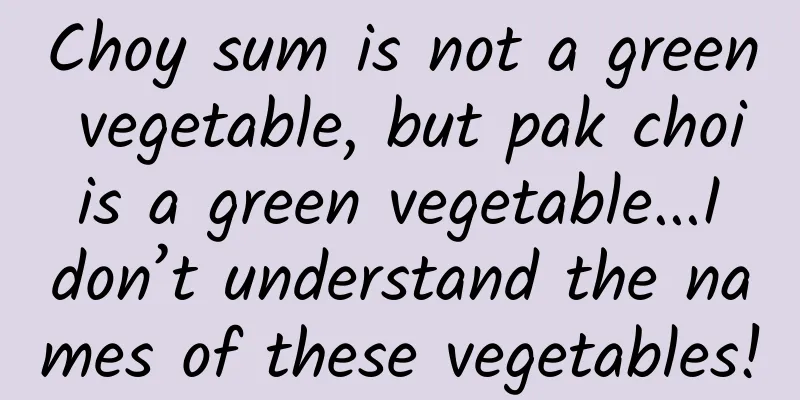Choy sum is not a green vegetable, but pak choi is a green vegetable...I don’t understand the names of these vegetables!

|
Whenever you go to the market to buy vegetables, do you always find yourself in a situation where there are too many vegetables and you don’t know what any of them are called? Of the vegetables we usually see in the vegetable market, about 50% to 67% belong to one genus, Brassica [tái] , which can be said to be the undisputed ruler of the vegetable market . Brassica plants are divided into three categories : cabbage type, kale type and mustard type , and they also have their own characteristics. Cabbage type Among the Brassica vegetables, the most familiar one to us is probably the cabbage type. Cabbage-type vegetables have no pungent smell, light green leaves, bright yellow flowers, and taste relatively light. What would you call this vegetable? Chinese cabbage, Shanghai green, or rapeseed? It may be one of the vegetables with the most names we encounter in our daily lives, but its official Chinese name is qingcai . Isn't it embarrassing? Aren't all green leafy vegetables called qingcai? Now that we have mentioned the name "Xiaobaicai", who does "Xiaobaicai" refer to? In most cases, the name "Xiaobaicai" is a general term, and all "cabbage" can be called "Xiaobaicai" when they are small. The pakchoi we usually eat comes from such a bloated cabbage. The outer leaves of the cabbage block the sunlight, causing the inner leaves to lack light and reduce the amount of chlorophyll synthesis, which is why the inner leaves look yellow-white. At the same time, the inner leaves also lack cellulose synthesis, which is why the "heart" of the cabbage is delicious and refreshing. In the name of the genus Brassica, the word "薹" means the stem of the plant that is used for flowering . There are also two types of cabbage-type vegetables that are specifically used for eating 薹, which are purple cauliflower 薹, which is rich in anthocyanins, and the Chinese cabbage heart that Guangdong people love to eat. What is the name of the following vegetable? Calling it radish is definitely correct! However, it is not a radish, it is a kind of root cabbage, called turnip [wú jīng] . The biggest difference between it and radish is that radish has a higher water content and tastes crispy , while turnip tastes soft like potatoes. Turnip is rarely seen in northern China because it is suitable for cultivation in high-altitude and cold areas. In Tibetan areas, it is used as both a vegetable and feed. Brassica oleracea The second type of Brassica vegetables is the Brassica type . Brassica vegetables have a milder pungent odor, bluish-green leaves with glaucous frost, a stronger flavor, and yellow-white flowers. The ancestor of Brassica oleracea is wild cabbage , which looks like a weed with small yellow flowers. Wild cabbage is distributed along the Mediterranean coast, so Brassica oleracea is basically cultivated in Europe . Brassica oleracea fully reflects the variability of Brassica vegetables. Basically, whatever part humans want to eat, they can cultivate the corresponding vegetable. The first is the leaf type of cabbage, such as the Savoy cabbage , which has curled leaves and greatly increases the leaf area, which means that the edible part is also greatly increased. There is also an ornamental variety called kale , which we often see in flower beds. Many friends who eat fat-reducing meals may eat kale, but the leaves of kale are very tough and really not delicious. People also used the toughness of cabbage-type vegetables' leaves to cultivate other vegetables, such as cabbage . Cabbage was introduced to China by sea during the Southern and Northern Dynasties. People at that time saw that it had blue leaves and tasted sweet, so they gave it the name "cabbage". Cabbage has different names in different places: cabbage, cabbage, lotus white, kohlrabi, etc. The "big head" of cabbage is developed from the terminal bud, and there is another vegetable whose spherical body is developed from the axillary bud, which is Brussels sprouts . Brussels sprouts appear more frequently in Western cuisine, but Brussels sprouts have a strong taste when eaten raw, so they are generally not used in salads, but are eaten after being roasted. If leaves can undergo such exaggerated metamorphosis, then metamorphosis of inflorescences is certainly inevitable in cabbage-type vegetables. Cauliflower is also a cabbage-type vegetable, but the bulbs of the vegetables mentioned above are all composed of leaves, while the bulbs of cauliflower do not have developed inflorescences . When cauliflower grows up, its inflorescence will spread out and cauliflower stalks will emerge from it, and finally flowers will bloom at the top. The cauliflower family also has the Roman broccoli , which is very beautiful. Roman broccoli looks like a fractal structure in mathematics, and each small side bud can be seen as a replica of a larger side bud. Another type of cauliflower that we are more familiar with is broccoli . Broccoli develops later than cauliflower. If you look closely, you can find that each small ball on broccoli is a bud juvenile . Another abnormal situation is the abnormal stem . The Chinese have also made some contributions to the cultivation of cabbage-type vegetables. We have cultivated Chinese kale . The lower part of the stem of Chinese kale is thicker, which is also its main edible part. Chinese kale is the only cabbage-type vegetable that blooms white flowers . The rest of the cabbage-type vegetables bloom yellow flowers. Imagine that we blow air into the stem of kale, making it swell into a ball, and we get kohlrabi . The difference between kohlrabi and the previously mentioned turnip is that the petiole of kohlrabi grows out of the middle of the ball, which means that the swollen part is its stem rather than the root . The most important type of cabbage-type vegetable is Brassica napus , which is the component of the large rapeseed fields we see every day. In February and March every year, the young stems of Brassica napus can be picked and eaten, which is called "green rapeseed". Mustard type The last type of Brassica is the mustard type . Mustard vegetables are usually not eaten directly because they usually have a strong pungent smell and taste either too bitter or too spicy. They are usually pickled before eating. The seeds of mustard can be collected and pressed for oil, but in China, the main use of mustard seeds is to grind them and use them as mustard . The seeds of mustard have a slightly spicy taste, which is also the origin of real mustard . The mustard that we are more familiar with now is usually made from plants such as wasabi. The most common leaf mustard is the large-leaf mustard , which has relatively developed petioles and tastes slightly bitter. The taste of Chinese mustard greens is too strong, so it can only be eaten after being pickled. Chinese mustard greens are the main source of the sauerkraut we usually eat . Of course, the main source of sauerkraut varies in different regions and dishes. The sauerkraut in sauerkraut fish is basically Chinese mustard greens, while the sauerkraut in sauerkraut pork and vermicelli stew is pickled with Chinese cabbage. There is also a more common root mustard called kohlrabi . The pickled product of kohlrabi is called pickled cabbage in the north and kohlrabi in the south. This guy who looks a little bit claustrophobic is called Brussels sprouts . In some places, it is also called ercai . The large part in the middle is the "daddy" and the smaller parts around it are the "sons". These "sons" are all developed from axillary buds , just like the Brussels sprouts mentioned earlier. 95% of people may have eaten this dish, but 90% of people don't know what it looks like when it is alive. It is "Zhacai", formally known as Tuberous Mustard . Zhacai is made from the stems of Tuberous Mustard, which need to be repeatedly squeezed to remove the water during the pickling process, which is also the origin of the name "Zhacai". After reading so much, are you more confused about the names of Brassica plants? Next time you go to the vegetable market, you can be more careful. Author: Gu Yourong Cover image source: Gu Yourong This article comes from GuokrNature (ID: GuokrNature) If you need to reprint, please contact [email protected] Welcome to forward to your circle of friends |
Recommend
Anqing SEO Training: Do visitor preferences affect visit rate? How does SEO grasp visitor preferences?
A good website is undoubtedly the hard work of ma...
4 promotion and customer acquisition channels for APP promotion!
New users are the source of business growth. Well...
Scenario-based operation: Change your thinking and plan a generous anniversary event
Imagine an anniversary event, just like your own ...
2021 Updated Finished Dance Full Show + Mirror Analysis Teaching
021 Updated Finished Dance Complete Show + Mirror...
The vibrant green is actually the color of death?
This painting, in bright green, makes the whole r...
Zhihu’s operational strategy
I recently updated the Zhihu app to 6.46.0., and ...
What kind of clam is the mulberry wine in "The Eternal Moon"?
Recently, the Xianxia drama "Chang Yue Jin M...
surprise! Open an account for Double 12 Information Flow and receive RMB 6,000 in cash!
As the year draws to a close, the company's v...
Extinct duck species
Geese and ducks are almost one of the most famili...
How to cancel the administrator in Jinan WeChat mini program?
Q: How to cancel the administrator of WeChat Mini...
Plants can actually give birth to live young. Seeds float on water, so there's no need to worry if they fall into the sea!
People who have never seen mangroves must think t...
How to improve users’ acceptance of advertising? Here are 7 techniques!
Those great advertisements often come from the bra...
What aspects should be taken into consideration to build a good UGC platform?
UGC , or User-Generated Content, refers to conten...
With customer acquisition as the goal, how to achieve user growth from 0 to 1?
If the goal is to acquire customers, then you nee...
With lightweight operations and products that have great reputations, what are the secrets of Keep that have attracted 50 million users?
Wang Ning, the founder of Keep, was born in the 1...









